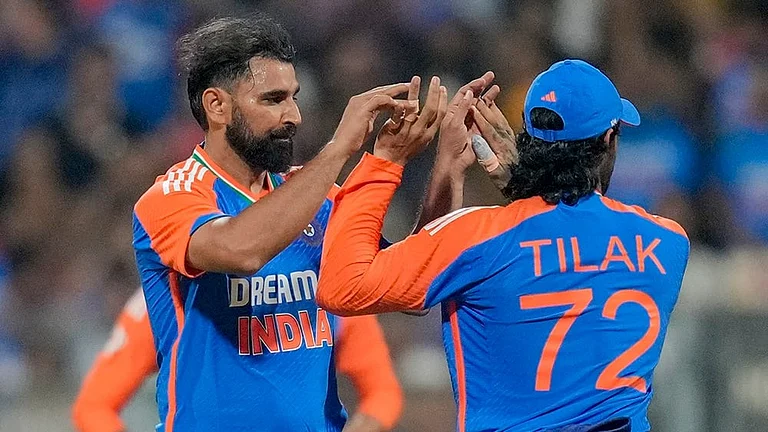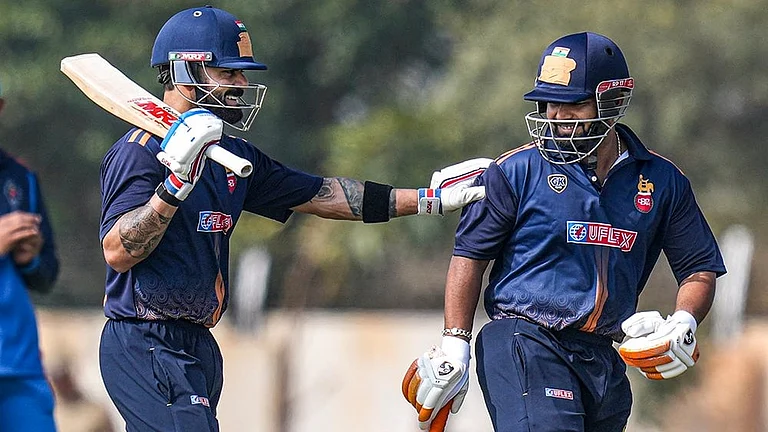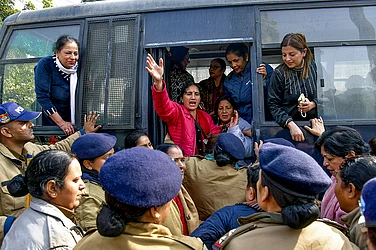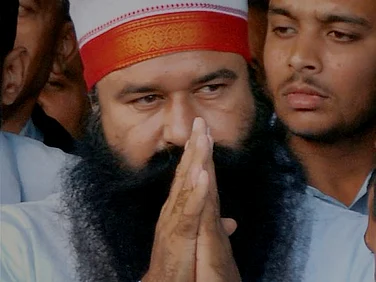That's the macro-view. The reality, of course, is infinitely more complex. Caste remains the staple in Bihar, but this time around the supplements are numerous. Led by Chief Minister Laloo Prasad Yadav, the Janata Dal and its allies , which won 46 of the 52 seats contested in 1991, know that caste equations favour them. But, in a sporadic and localised phenomenon, the Congress seems to have stirred itself belatedly into combat mode. This may not translate into more seats than it got last time, but the Dal is likely to suffer as a consequence.
Take the 14 seats in south Bihar. The JD-Left combine's hold here is tenuous at best, unlike the BJP which went into its campaign on a good wicket. The JMM(S), which won six seats last time, has broken its alliance with the Dal. Add to that the Congress' last-minute frenzied appeals—Rajya Sabha MP Gyan Ranjan and BPCC chief Sarfaraz Ahmed, virtually camping in Jharkhand, are hammering in the point that the Muslims should not "waste their vote" on the Dal as it will only help the BJP. The newly-assertive Church, which can influence Jharkhand's 30 per cent tribal population, completes the scenario. With the BJP's defeat as its one-point programme, it may decide to forget its aversion for the Congress as it's the next best horse.
What these campaign crosscurrents ensure is that it's a no-win situation for Laloo—a resurgent Congress means a split in non-BJP votes. And that party, despite all the vicious infighting, is propped up by a firm urban support-base of traders, a section of the non-Christian tribals and the Sadans (Chhotanagpur's non-indigenous residents). What keeps the Dal in the race is only Laloo's shrewd candidate selection—and half-a-dozen poll-eve defectors who got JD tickets testify to its scarce resource-pool. The faction-ridden JMM(S) is in no better shape. Apart from Dumka (where Shibu Soren is contesting), it has a decent chance in only a few other seats.
Of the 40 seats in the rest of the state, the JD-Left is strongly placed in a majority—its Muslim-Yadav vote-bank is intact, though there seems to be a degree of erosion in its Dalit support. The Samata Party-BJP alliance is the main challenger, but its leaders are already covering themselves with talk of "Laloo's vote-rigging tactics." Frontmen like Nitish Kumar, George Fernandes, Brishan Patel, Anand Mohan Singh and Abdul Ghafoor have the upper-caste and Kurmi votes, which can tilt the scales in some places, nearly vouchsafed to them. What is unsettling them is Laloo's self-avowed aim to wreak vengeance on "these traitors".
The CPI(ML), contesting 22 seats, may cut into the Dal vote-bank in north and central pockets. And Congress bigwigs like Ram Lakhan Singh Yadav (Ara), Tariq Anwar (Katihar), Dhanik Ram Mandal (Jhanjharpur) and Krishna Sahi (Begusarai) can any day put up a stiff fight. But Laloo has a neat antidote in his unabashed caste criterion: the majority of seats have been allotted to OBCs, Dalits and Muslims but he has not fought shy of giving tickets to 'forward castes' in areas where their vote may be decisive, such as Vaishali and Barh.
The ruling Left Front in West Bengal has been goaded into a high-intensity campaign by a dread of the anti-incumbent vote, which first had an impact in the panchayat and civic polls in 1993-94. In theory, the prospects for an Opposition resurgence never looked brighter. But the fortnight-long farce that saw Somen Mitra and Mamata Banerjee slug it out openly over seat-sharing and candidate selection may have repelled much of the floating vote the party was expected to garner.
But the fear of a swing factor—even a 1-3 per cent swing can change fortunes in 50 assembly and eight Lok Sabha seats—has prompted the Left to concentrate on negative campaigning. Chief Minister Jyoti Basu, who addresses meetings in a new district each day, and other stalwarts like Buddha deb Bhattacharya, Ashok Mitra and Biplab Das Gupta are harping on Ayodhya and the scams. The attack on BJP is also tangential. Its own 'achievements', rural reforms etc, are offered almost apologetically.
But the Left campaign, which was set rolling as long back as November, has a clear headstart. For, the Congress is still ailing from an acute lack of preparedness. On April 17, a Youth Congress leader of the Howrah area (Priya Ranjan Das Munshi is contesting this prestigious seat) said: "The election office here was opened four days ago. The candidate hasn't yet come here. We have no money to carry out minimum postering and campaign work, although the AICC sanctioned Rs 2 lakh for each Lok Sabha seat." The plush CPI(M) office in the locality is humming with activity, the near- by walls full of Left posters. In contrast, a one-mile stretch down a main road in the area had only two Das Munshi posters.
The situation in the hinterland is even more pitiable. In Midnapore (51 assembly seats) and 24-Parganas (54), the Congress has not held regular meetings for long, except a few addressed by Mamata Banerjee for her personal campaign. In contrast, even the BJP appears vigorous. Says state BJP chief Vishnukant Shastri: "We're really frontrun-ners here. We're the only alternative to a discredited Congress and a non-performing Left. We had 11 per cent votes last time and we'll do better this time, wave or no wave."
Thus, the chief worry for Basu—who won by over 20,000 votes in Satgachia last time—is not Congress candidate Chitta Bag but the BJP's young Muzaffar Khan, who had got 63,000 votes in the Diamond Harbour Lok Sabha seat in 1991. Khan has put up a spirited campaign focusing on Basu's lack of concern for the constituency. "Just how many times has he visited Satgachia? I bet not more than five times in these 15 years. I challenge him to visit Bawali, Chakmandir and Rania, where there's no drinking water after 19 years of Left rule," says he. Strong campaign stuff, but the Left knows how to tackle it. A local leader explained: "Basu is not of the Congress mould, he wouldn't think of nursing a constituency."
In South Calcutta, Mamata is pitted against the more conservative Dr Bharati Muk-herjee of the CPI(M). Unfazed by Mamata's 93,000 victory margin in 1991, the CPI(M)'s debutante avoids hyperbole: "I am trying hard, but it is for the voters to decide." In Berhampore (Murshidabad), former chief minister S.S. Ray is on a sure comeback trail. Surmounting open hostility from the Somen Mitra camp, he has rented a house in the town to organise his campaign against his RSP rival. Although the Left takes Berhampore as a prestige issue, in the absence of the late Nani Bhattacharya, the RSP doesn't seem equal to the task.
In Orissa, a sluggish campaign period is itself like a weather forecast—the absence of clear issues has always benefited the Congress by default. What's more, even party supremo and star campaigner Biju Patnaik admits that the Janata Dal's resources are thin. Add to this Prime Minister Narasimha Rao's adoption of Berhampur as his safety-valve, and the Congress campaign looks more robust. Rao has, willy-nilly, set the agenda even for Biju Patnaik, who is contesting from Cuttack and Oska. His exhortation is the same everywhere: throw out Rao from Berhampur. "Both Telugu Desam factions are taking credit for driving out Rao from Andhra. It's now Orissa's turn," he told a Cuttack crowd, likening Rao and his Cabinet to "Ali Baba and chalis chor".
Biju's campaign trail has at best only touched his strong point—coastal Orissa, regarded as an anti-Congress base. Cross Bhubaneshwar and move towards the south, and the scene changes dramatically. Congress projections paint a rosy picture in the south and west—Koraput (where Giridhar Gomango, with his forays into tribal music, is providing some colour), Navrangpur (seven-time winner Khagpati Pradhan is contesting) and Kalahandi (where hot favourite Subhash Naik avoids mention of starvation deaths).
Biju's challenger at Aska, Ram Chandra Rath, is expected to give him a run for his money. Chief Minister J.B. Patnaik has an agenda of close to 100 big and small public meetings in 10 days. Of special interest to him is the Bhubaneshwar seat, where son-in-law and media magnate Soumya Ranjan Patnaik, is battling the CPI(M)'s Shivaji Patnaik. In Dhenkanal, K.P. Singh Deo's 'underground campaign' has been even quieter than his stint as I&B minister.
A new factor is the use of youth clubs, formed with little financial support. In Puri, Congress candidate Pinaki Mishra—dubbed "Chandraswami's lawyer"—is said to have bought many of these clubs, which are canvassing full pitch for him.
In Assam, Murphy's Law has been at work for the Congress from day one. Chief Minister Hiteswar Saikia is unwell and in no position to go through the campaign rough and tumble. There are 70 Congress rebels in the fray and the Congress (T) has fielded candidates in 123 assembly seats. The party manifesto had not seen the light of day until April 20. And, then, there's the ever-present threat of extremist violence—in lower and upper Assam, candidates haven't been campaigning because of the ULFA, and the Bodo threat has had a similar effect in Kokrajhar and Darrang.
In contrast, the Asom Gana Parishad-led five-party combine, though less flush with funds and operating out of makeshift offices, is sitting pretty. AGP leader Prafulla Kumar Mahanta hit the campaign trail in the second week of April itself—Bihu festival time—using low-key door-to-door canvassing to establish direct contact with the electorate in his Nagaon and Barhampur assembly segments. The BJP is making headway outside the Barak Valley. L.K. Advani spent three days in the state and hijacked the foreigners' issue from under Mahanta's nose by promising to scrap the Illegal Migrants' Act of 1983. The AGP, silent on this subject, seems to be competing with the Congress for Muslim votes. It has committed itself to lifting the ban on the ULFA and addressing the illegal migrants' issue under the Assam accord.
For the electorate of Tripura, Nagaland, Sikkim, Arunachal Pradesh, Mizoram, Meghalaya and Manipur—who together elect 11 MPs—the polls are yet another con-firmation that they have a marginal say in the running of the country they belong to. In most of these states, the battle is between the Congress and its allies and various regional groupings (apart from Tripura, where the CPI(M) is the main rival).






















